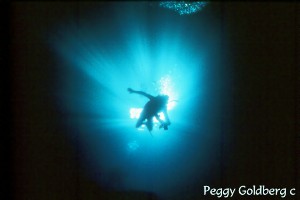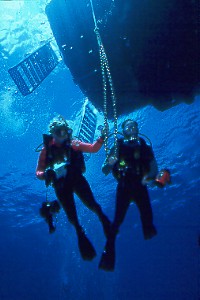|
In my previous articles on getting
started in underwater photography, we talked about controlling
buoyancy and getting comfortable with your diving skills. We
also touched upon the need to get very close to your subject,
looking up and spending time with each shot - changing
strobe positions and distances, and bracketing exposures.
Taking as many different shots of your subject as you can
will increase your chances of a "keeper", as will trying to
shoot macro first. We also warned you about focusing
underwater -using the apparent distance, not the actual
distance to determine how you focus. When you use your
rangefinder Nikonos, be aware of parallax error at close
distances. If this all seems Greek to you, and you have no
idea what I’m talking about, review the previous four articles
first.
Here are some more helpful hints for the beginner
that will help you get more successful faster....some of these
rules also apply to land/nature photography, too.
I can’t stress enough how
important it is to approach one photographic problem at a time. Don’t try
to learn everything at once - as I’ve said above,
try macro first.

Flamingo tongue and sun-
Using my housed camera with a 60mm lens, I decided to try a
more "environmental" shot of the Flamingo tongue in it's
natural setting, with the sun behind. Again, I could
have taken a macro shot with the same lens (looking like
every other macro shot of the snail), but decided to try
something different
Once you get good and comfortable
with that, then get into wide angle.

Sea fan, sun , and anemone - Using a 15mm lens, I got within 1-2'
of this large anemone, positioned myself so the sun was behind
the fan for a more dramtic effect. I metered for the open
water, and set the strobe for the distance. You can also try
using 1/4 power and see how your strobe does.
This is
the hardest one of all for any photographer. Record the
technical data (i.e., shutter speed, distance, aperture, etc)
as you take you shots. You will find out which settings
work best for you. This will save you an enormous amount of
time and film later on, and reduce future mistakes. This is
the one piece of advice that most photographers really need
to do over an extended period of time, but will throw out the
window and forget to do after the first roll of film....How
much do you wanna bet? (I should talk, even with the best
intentions to do so, I forget, too!)
Before your dive, note the
position of the sun. You may want to take some of your shots
with the sun in them for dramatic backlit and silhouette
shots.

Diver
in silhouette- When you are too far away to use your strobe on
the subject, try putting the sun behind the subject for an
interesting effect
At first, don’t try and refocus
for each shot - preset the focus for around 3-4’ and approach
your subject (slooowly) until it is in focus. Note those
little red markers in the lens - that is your depth of field
indicators. They tell you what will be in focus at those
distances. I will talk about this in more detail in the
future.
Preset your strobe out of the water first, for the
subject distance you are most likely to use. When you need to
aim the strobe at your subject underwater, aim the strobe
one-third behind the subject. Remember in the last article,
where we talked about actual and apparent distance? Your
subject is actually behind where you see it, so when you aim
behind the subject, you are actually aiming at your subject!
(Remember, when you focus, the reverse is true - you focus at
the apparent distance). Keep repeating this phrase
-"Isn’t underwater photography fun?"
Now you know why a lot
of underwater photographers are going bald (from pulling out
their hair), or going prematurally grey. And this is only the
beginning!
Don’t get discouraged, though, with a little
(heck, a lot), of practice it will all become second nature to
you. Unless of course, you only do that one dive trip a year,
and don’t touch your underwater camera til the week
before....then you are screwed.
Contact me at pgoldberg@goldenimages-photo-scuba.com
with any questions, comments and
suggestions. Dive
Safe! |



